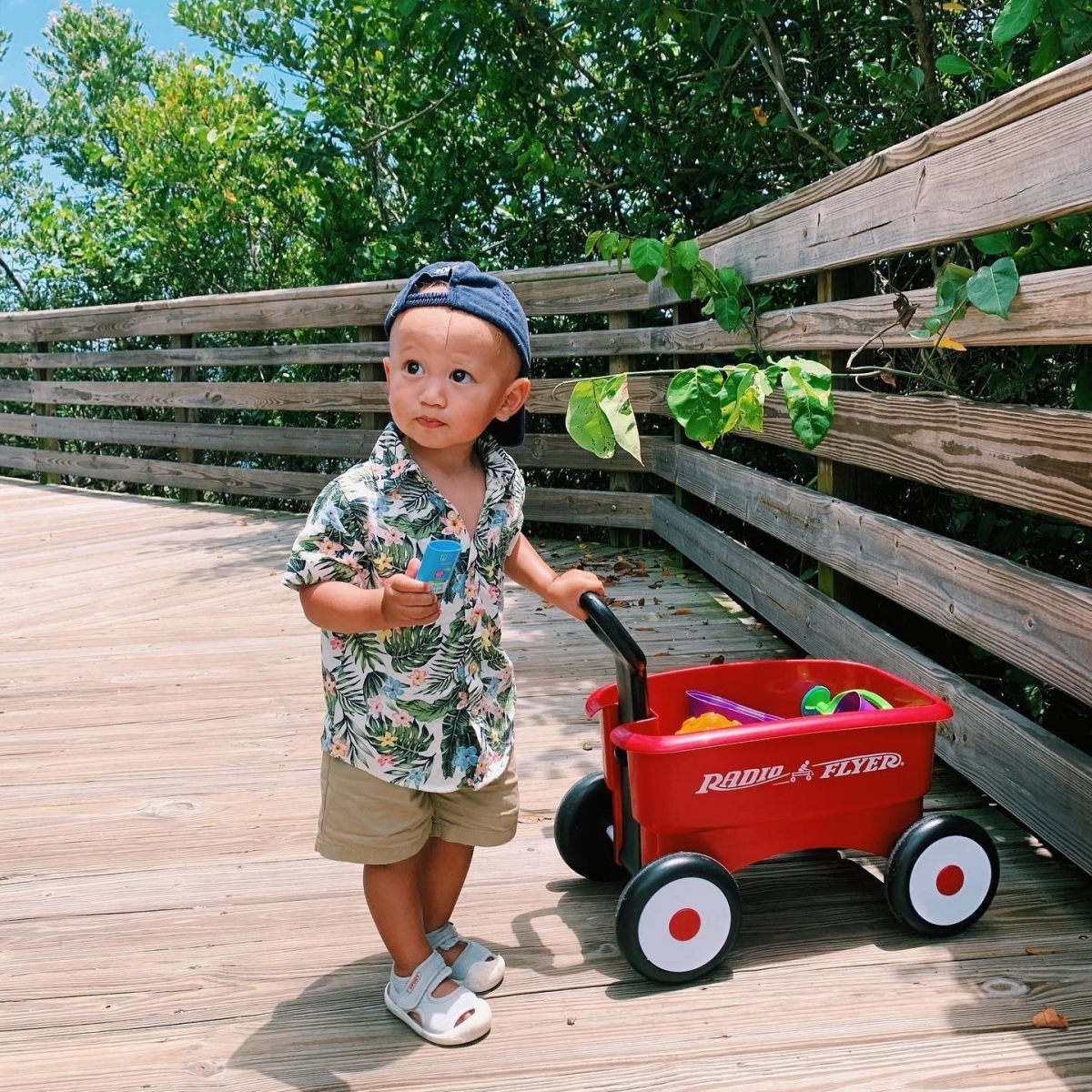Processing the Pandemic: How to Support Your Child’s Emotional Needs & Begin to Move Forward
Our Blog: Word on the Sidewalk
Processing the Pandemic: How to Support Your Child’s Emotional Needs & Begin to Move Forward

One sunny day in March of 2020, I took my son for a routine visit to the playground. As it turned out, it would be our last playground visit for months. I tried to explain the Covid-19 pandemic to my child in words that a toddler might understand, telling him that the playground was closed until people were safe and healthy again. When my husband and I decided that the playground was “open” to us again, we ventured to a small park. We were the only people there, and my now-three-year-old was so excited to have the climbing structures all to himself. I felt so much joy and relief in that moment – here was the beginning of a return to normalcy.
A few weeks later, though, we went to a busier playground and my son froze, refusing to leave my side. I wasn’t sure what was wrong until he whispered fearfully, “Mama, there are other children there.” My sweet boy had been told so many times that he needed to give other people their space that he was now terrified to go near other kids. That moment highlighted for me just how much of an impact the past year had had on my son.
Since the pandemic began, adults and children alike have experienced multiple changes and losses, some much more devastating than playground closures. It is impossible to know what the full impact of the pandemic and lockdown will be on children. It is likely that many children will display some form of anxiety or other emotional distress as we begin to return to some semblance of our pre-pandemic lives. Children can display distress in many different ways including the following:
- Sadness or frequent crying
- Irritability or frequent mood changes
- Loss of interest in favorite activities
- Worrying (may or may not be directly related to Covid)
- Clinginess, increased difficulty with separation, or school refusal
- Withdrawal from others and self-isolation
- Angry outbursts or tantrums
- Defiance and oppositionality
- Physical symptoms such as headaches or stomachaches
- Difficulty concentrating or a decrease in academic performance
- Sleep difficulties or appetite changes
In general, the following can help your child manage their emotions as they continue to process living through a pandemic:
- Regularly check in with your child regarding their feelings about the pandemic and the related changes to their lives. You may want to use a feelings chart to help your child share their emotions.
- Maintain as much predictability as possible in your child’s daily routine. Children thrive on consistency and predictability. Covid upended many children’s routines, and they had to adjust to an entirely new schedule and new expectations. As restrictions are relaxed, children must once again adapt to a different set of rules and circumstances. Schedules may be changing with a return to work and school, but keeping consistent morning routines, mealtimes, and bedtime rituals can help children to feel secure.
- Try to manage your own worries. Empathize with your children, but do your best to project a sense of calm.
- Ensure that your child eats healthfully, gets enough sleep, and engages in daily physical activity.
- Practice mindfulness activities with your child to help learn to calm themselves and remain present.
- Modify your expectations and understand that it may take more time than you expect for your child to adjust back to pre-pandemic levels of functioning.
More specifically, here are some potential effects of the pandemic that your child may experience in a post pandemic world, and suggestions for how to help them as we continue to navigate the challenges of the pandemic:
1. Distress related to the return to in-person school
Many children have been out of school for over a year. In the fall there will be kindergartners who have never before set foot in a classroom and middle schoolers who did not have a chance to say goodbye to their elementary schools. Even for children who will be returning to a school they have previously attended, the long absence may cause worry and distress. Further, children who were initially excited to return to school may be disappointed to discover that Covid safety precautions mean that school is not the same as it used to be. Whenever the time is right for your child to return to school, taking steps to adequately prepare them will ensure a smoother transition.
- Talk to your child about their feelings about going back to school and help them understand that whatever they are feeling is fine.
- Help your child find something to be excited about on the first day of school, such as picking out a special outfit or planning a favorite dinner for that day.
- Visit your child’s school grounds in the weeks leading up to the return so that your child becomes refamiliarized with their school.
- Talk to your children about their memories of school and review any changes that they can expect with them.
- Be prepared for an adjustment period and be aware that your child may be more irritable and/or emotional after returning to school, even if they were initially excited about going back.
- Be understanding if your child’s academic performance is temporarily affected. Give them a chance to readjust before pushing academic demands.
2. Fear in groups
When it feels safe for your family, you and your child may begin to rejoin group activities. Like my son, children who have had limited exposure to other kids over the past year may be nervous as they return to situations where they are confronted with groups of children, such as rejoining sports teams or beginning to attend birthday parties again.
- Prior to attending such an event, prepare your child by letting them know that there will be a larger group than they may be used to and assess their reaction to this.
- Reassure your child that you think the situation is safe and give them the specific reasons why you think this.
- Discuss with your child what might help them to feel most comfortable – whether that is wearing a mask, bringing a favorite toy from home, or having you stay with them.
- Recognize your child’s limits and allow them to take a break from the activity or leave early if needed. At the next opportunity, try to have them stay a few minutes longer and increase the time as gradually as needed until your child is comfortable in these settings again.
3. Delays in social skill-building
Although adult caregivers certainly are important models of healthy social interactions, peer relationships are essential to children learning social skills such as sharing, taking turns, respecting the space and possessions of others, communicating clearly, listening, managing disappointments, and establishing age-appropriate independence. Without playdates, extracurricular activities, and regular peer interactions at school, children have not had the chance to practice these important skills. Rest assured that your child will be able to catch up on these skills once they begin to have increased opportunities to play with friends. Each family must make their own decision about when they are comfortable having their children play with friends again. In the meantime, here are some ways to practice social skills at home:
- Play board games with your child. Board games teach turn-taking and rule-following and help your child to tolerate disappointments like not always winning. For very young children, even just rolling a ball back and forth can teach some of these skills.
- Simon Says is a great, simple game to play with your kids to help them work on impulse control and listening skills.
- When watching TV or reading a book with your child, stop to ask them questions about how they think the characters are feeling. Read books that specifically are about feelings to support your child’s ability to recognize the emotions of others.
- Encourage your child to engage in pretend play and use the play to practice different social skills. For example, use puppets to have your child practice appropriate greetings. If your child sets up a pretend restaurant, you can take the opportunity to help them practice table manners.
- If your family is not yet ready for in-person play, set up some virtual playdates for your child. Even young children can enjoy listening to a story or doing a craft together during a video call. This will give them practice listening to other and engaging in back-and-forth-conversation.
4. Fear of exposure to germs and illness
Many parents have spent months explaining to our children that they need to wear masks, wash hands frequently, and maintain a distance from other people so that they don’t get sick. Even when you decide that the world is safe enough to begin engaging in more activities and social outings, some children may still be very nervous about being exposed to germs and become anxious if they hear that someone they know is ill, even if this is non-Covid-related.
- Review with your child the steps they can proactively take to stay healthy and point out the precautions that stores, schools, and other places are continuing to take.
- Provide your child with facts about illness so that they have a realistic understanding of potential risks.
- Do your best to manage your own anxiety in this area as your child will pick up on any concerns that you have.
5. Separation Anxiety
After over 365 days of being home with loved ones, children may struggle to suddenly be expected to separate from their caregivers. Whenever your family makes the choice to return to pre-pandemic childcare routines, you may notice behaviors in your child that did not exist prior to the pandemic. A child who easily entered school or happily greeted a babysitter before the pandemic may now be clingy and become distressed when they are expected to say goodbye to their primary caregiver.
- Practice separating for short periods of time before leaving your child for an extended time.
- Develop a special, but brief, goodbye routine – a special handshake or a funny thing you say to each other.
- After saying goodbye, let your child know what time you will be back and leave quickly and calmly.
- Leave your child with a comfort object or a favorite family photo.
- Do your best to be on time when returning home or picking your child.
- Notify your child if there is going to be any change in the usual schedule.
6. Apprehension regarding visiting with friends and relatives
Many adults are eager to connect with friends and family again. Grandparents have been counting down to the day when they can visit with their grandchildren again. Many children may feel the same way, but some may be more hesitant when it comes to seeing faces that may have once been familiar but no longer are. Whenever you decide that the time is right for your family to expand your social circle, be mindful that your children may not be as immediately able to return to previous levels of closeness in relationships.
- Give your child advanced notice before reuniting with any relatives that they have not seen in a long time (even if they have had video or phone contact).
- Respect your child’s physical boundaries. Your sister may be eager to give her niece a hug, but a young child who has not seen a relative in over a year may not initially be comfortable with that type of contact.
- Provide your child with opportunities to reconnect with friends and family in settings that are comfortable for your child. Be understanding if it takes several meetings before your child begins to warm up.
7. Sadness over the end of staying at home
While staying home may have been boring for some children or caused tensions in some families, for others, the past year has been a relief and a reprieve from the hectic whirlwind of activities. For these children, a return to pre-pandemic schedules may be distressing. They may have enjoyed being at home and spending more time with parents or other loved ones. Even kids who are eager to return to activities likely have at least some things they preferred about their pandemic lives.
- Talk with your children about what, if anything, they enjoyed about staying at home.
- Consider which pre-pandemic activities you and your children missed and which you realized you are happier without or would prefer to continue in a virtual format.
- Did your family develop special rituals during the year like an evening walk together or establishing a family movie night? Try to maintain these activities even as the pace of life increases. This is an important lesson to your children about the good that can come from even the most challenging of situations.
If your child continues to show signs of emotional distress or behavioral problems after a few months of a readjustment period; if their distress seems to be more severe than expected (e.g., crying every night, refusing to enter the school building, exhibiting physical aggression, intense fear that something bad will happen to a loved one, etc.); or if your child experienced the loss of a loved one during the pandemic they may benefit from play therapy, a form of mental health treatment that uses child’s natural tendency toward play to help them process complicated emotions they may not otherwise be able to express. The Association for Play Therapy and Psychology Today are two resources for finding a therapist qualified to treat children.
After a couple of visits to the playground together, first watching other kids play and then slowly joining in, my son happily returned to running, climbing, and sliding. The road to “normalcy” has been a little bumpier than I expected but now we are on the way and your family will find their path as well.
Danielle Rothman, PsyD
Danielle is a licensed clinical psychologist. She currently practices with Insight Into Action Therapy, located in Ashburn, Virginia. One of Danielle’s areas of specialization is providing play therapy to young children. She strongly believes in the healing power of play.













 Back to Blog Home
Back to Blog Home